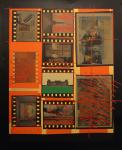Collaborative Work
Collaborative Work
Masi and Colverson chose to work together in a mutual collaboration. This was a positive choice in a positive spirit, to jointly share their individual ideas and their individual interests in certain ways of working. They were particularly interested in the use of print and its various methods of production. This recursive process was a real attempt at a relationship in problem solving and making work. For them collaboration was just another way of working among the many other ways to produce work. This was another method to make something new, and it was an opportunity to jointly explore certain aspects, which both artists shared, of contemporary art and society. This approach was the formative base for both the Berlin Suite (the city as subject) and Art Sign (the commercial environment and billboards as a site for art).
At the time of their collaborative initiatives, in the early 70s, this was not a common practice. Their activity at that time was just an example of one model of collaboration. Many other models have evolved over the past 40 years and before of artists working together or in units such as Dada, Fluxus, Situationist International, Experiments in Art and Technology (E.A.T.) and Colab (the New York City artists’ group Collaborative Projects).
In recent years collaborative art practices have moved in to the mainstream of cultural production, and collaboration is now largely taken for granted as one of the numerous ways that artists can choose to operate. Gilbert and George are a time-honoured example of the collaboration model but the most recent and obvious exponents of a collaborative practice in the UK are Langlands and Bell, Jane and Louise Wilson, Jake and Dinos Chapman, Alan Kane and Jeremy Deller, and Sarah Lucas with Tracey Emin.


